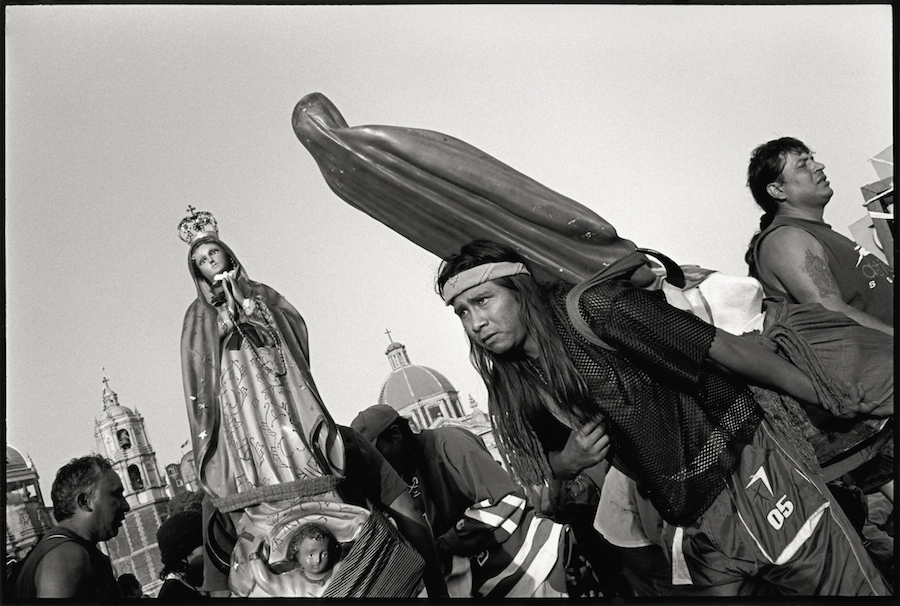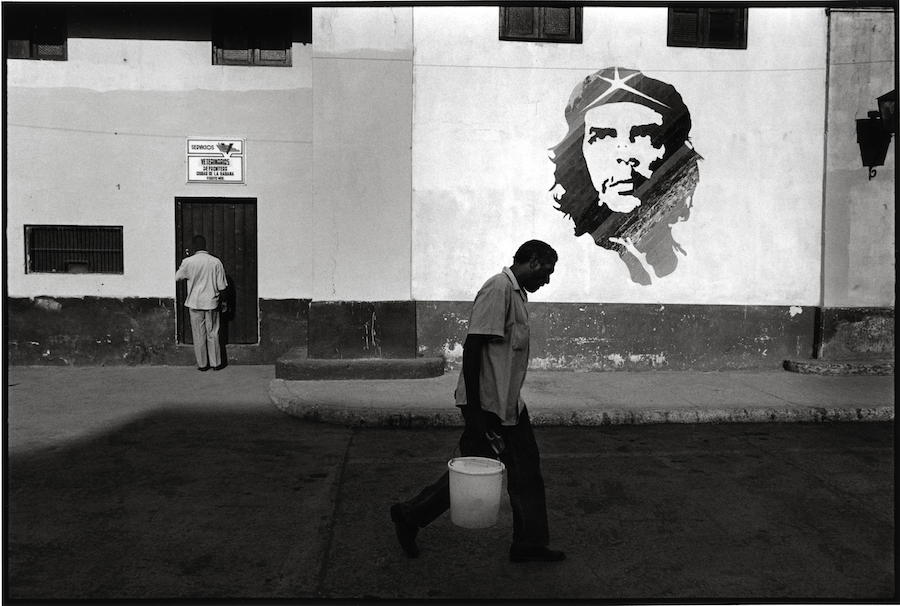Photo: “Baptism #1,” Jordan River, Israel, 1996, silver gelatin print by Ralph Burns
At what point does a cultural icon or a town begin to take on a spiritual or even a religious identity? Can they be transformed by merit alone, or is it through cross-cultural, multigenerational dedication and obsession? And what of religion itself — can it be found in commerce and everyday practices and routines?
Such is the exploratory pathway set by the more-than-120 photographs in Ralph Burns: A Persistence of Vision, 1972 – 2013, a new exhibition opening this Saturday, March 29 from 5 to 7 p.m. at the Asheville Art Museum. The show, curated by J. Richard Gruber, Ph.D., the Director Emeritus of the Ogden Museum of Southern Art, surveys 41 years of work by Asheville photographer Ralph Burns.
Gruber has grouped the works both by concepts and sequences explored in a variety of locations ranging from New Orleans, Burns’ hometown, to Asheville, Cuba and Israel. The entire show has been shot and hand-printed in black and white, with the exception of one cluster, “Tobacco Series,” and a handful of sporadic street scenes.

“Festividad de Nuestra de Guadalupe #1,” Mexico City, Mexico, 2003, silver gelatin print by Ralph Burns
The photographs collectively examine politics and personalities, simultaneously pairing and pitting them against one another. They arc through a series of moral codes and commercial trends and reflect not only the practitioner’s spiritual dedication but also Burns’ reverence for his subjects and medium. Some depict a host of cultural and historic icons and iconography from alternating vantage points of the stranger’s take and the native eye. Other photographs explore religious practices — both free-form and organized, individual and societal.
“Beginnings (1972),” the first group of these works, features a mix of street scenes, crowd shots and individual portraits that help set the show’s documentary overtones in motion. Each photo seems to be a momentary anthropological or psychological study. They offer isolated, yet interconnected stories and an early glimpse into the spiritual and religious interest that take root in Burns’ later works.
Despite the time-specific title, the exhibition actually beings in 1968 with a single image of Robert F. Kennedy. He’s speaking from an elevated podium with his hand posed in an effort to better articulate a point. Burns looks up from the lower audience level, capturing the then-Senator mid-sentence during a speech for his 1968 bid for the presidency.
In his New Orleans series, Burns explores subtleties in the outskirts of his hometown. He leaves behind the kitschy Bourbon Street party shots in favor of smaller neighborhoods and their drastically quieter and emptier streets and simple white-walled churches. In one image, which is also one of the few color photographs in the show, a street shot filled with monochromatic black, gray and brown buildings, bricks and pavement is broken by a soft-yellow car and a woman in a vibrant, Hawaiian-blue dress. She’s standing in a doorway, but she seems to rise out of the frame.
He’s taken similar liberties in photographing a seemingly abandoned and downtrodden downtown Asheville. Many of the photos capture a portrait of downtown that few transplants (myself included) would remember, much less have even seen. The streets are barren and occasionally littered with trash. A man sweeps in front of a tired-looking, grungy federal courthouse in one photograph, while others peek into the storefronts of long-gone businesses. One shot of the Walnut and Lexington Avenue intersection shows the building, now occupied by The Southern, boarded up.
In still another, he’s focussed solely on a church steeple. The image, among others, follows in the footsteps of photographers like William Christenberry and William Eggleston, who made both religion and emptiness regular subjects. Burns’ approach zeroes in on signage posted at the steeples’ base, which reads: “You had better Pray or the Devil will Get You.”
The sign is reminiscent of roadside evangelical churches and tent revivals and feels all-too-similar to the Bele Chere signage sported by street preachers during the now-defunct 3-day street festival. Similar messages appear in several of the works and resurface in a later series near or next to images of Klan members with their hoods pulled off, preachers saving the faithful and quiet stills of various Southern main streets.

“Che #1,” Havana, Cuba, 2001, silver gelatin print by Ralph Burns
But despite some of their numerous character flaws, Burns has a means of transforming should-be downtrodden subjects, mundane spaces and the decidedly evil, pagan or nonreligious beings into spiritually opulent figures and landscapes. While some are direct, such as those that focus on centuries-old religious practices and locales, many form an image of our cultural worship of a figure, like Elvis, or a product, like tobacco. He instills them with a sense of beauty — even dignity. And in a sense, they become collectively devout.
It’s this notion of worship which seems to bind each of the works together. And while it’s clear that Burns is fascinated by each of these subjects and their ways and means of life and livelihood, the show leaves any final interpretation open. He’s not taken any particular stance on the religious or commercial content. Rather, he’s amassed a detailed and open-ended document.
Ralph Burns: A Persistence of Vision, 1972 – 2013 opens this Saturday, March 29 from 5 to 7 p.m. at the Asheville Art Museum. The exhibition is on view through July 20. Admission is $8. For more information, visit www.ashevilleart.org.



Before you comment
The comments section is here to provide a platform for civil dialogue on the issues we face together as a local community. Xpress is committed to offering this platform for all voices, but when the tone of the discussion gets nasty or strays off topic, we believe many people choose not to participate. Xpress editors are determined to moderate comments to ensure a constructive interchange is maintained. All comments judged not to be in keeping with the spirit of civil discourse will be removed and repeat violators will be banned. See here for our terms of service. Thank you for being part of this effort to promote respectful discussion.